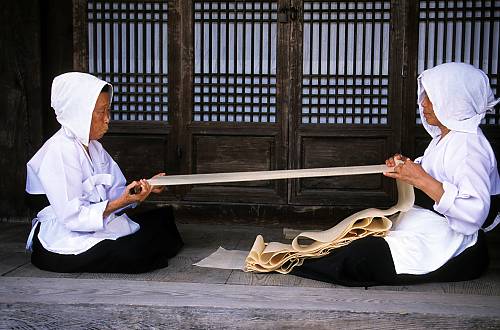Weaving of Mosi (fine ramie) in the Hansan region
Inscribed in 2011 (6.COM) on the Representative List of the Intangible Cultural Heritage of Humanity
Country(ies): Republic of Korea
Identification
Description

- Weaving of Mosi (fine ramie) in the Hansan region
- © 2003 by Cultural Heritage Administration
Weaving of Mosi in Hansan is transmitted by middle-aged women in the township located in South Chungcheong Province, Republic of Korea. The region boasts fertile land and sea winds that allow ramie plants to thrive. Weaving ramie cloth involves a number of processes, including harvesting, boiling and bleaching ramie plants, spinning yarn out of ramie fibre, and weaving it on a traditional loom. Ramie cloth is comfortable in hot summer weather and is used to produce a variety of clothing from dress suits and military uniforms to mourning garments. The whiteness of the bleached ramie fabric, as well as its refined quality and neatness, makes it suitable for high-end clothing as well as for clothing for ordinary people. Weaving of Mosi traditionally takes place in the form of women-led family operations in which mothers transmit techniques and experience to their daughters or daughters-in-law. The tradition also binds the community together with neighbours gathered and working in a designated section of the town. At present, around 500 people in the province are engaged in the diverse activities of weaving fine ramie.
Documents
- Nomination form: English|French
- Consent of communities: English/Korean
Decision 6.COM 13.45
The Committee (…) decides that [this element] satisfies the criteria for inscription on the Representative List of the Intangible Cultural Heritage of Humanity, as follows:
- R.1: Transmitted from generation to generation, Mosi cloth weaving is a traditional craft that is rooted in the community and provides its practitioners with a sense of identity and continuity;
- R.2: Inscription of Mosi weaving on the Representative List could help to enhance global recognition of the diversity of hand-woven textiles, thus promoting visibility of the intangible cultural heritage and awareness of its significance;
- R.3: Ongoing and future safeguarding measures show the commitment of the State and the communities to safeguard the element and promote the viability and transmission of the element to future generations;
- R.4: Following a request from the communities concerned, the nomination was elaborated with their active participation and demonstrates their free, prior and informed consent;
- R.5: At the request of the groups and individuals concerned, Hansan ramie weaving was designated in 1967 as Important Intangible Cultural Heritage by the Intangible Cultural Heritage Division of the Cultural Heritage Administration.
Requests the State Party to ensure that the communities will control intensified production and trade in ramie fabric, without compromising the continuity of the traditional craftsmanship or the natural resources used in its manufacture, and to address this issue in its periodic report;
Inscribes the Weaving of Mosi (fine ramie) in the Hansan region on the Representative List of the Intangible Cultural Heritage of Humanity.
Slideshow
Video
© 2009 by Cultural Heritage Administration of the Republic of Korea
These videos (and many more) can also be consulted through the UNESCO Archives Multimedia website





















